Figure 3. Amino acid signaling to mTORC1.

Amino acids (AAs), depicted as pink circles, may be sensed A) extracellularly, B) intracellularly, from within the C) lysosome, or through a combination. In addition, the specific AA sensed to promote mTORC1 activation is still not clear. For example, mTORC1 can sense 1) leucine through leucyl-tRNA synthetase (LeuRS) and 2) glutamine levels. Glutaminolysis results in mTORC1 activation, whereas glutamine synthesis seems to inhibit mTORC1 (Box 1). In response to AAs, an active RagA/BGTP-RagC/DGDP physically interacts with regulatory-associated protein of mTOR (Raptor) and recruits mTORC1 to the lysosome to promote its activation by Rheb, another GTPase. Recently, TSC2 has also been reported to localize at the lysosome (TSC1 and TBC1D7 have not yet been identified to reside at the lysosome, denoted by ?). The mTORC1 interaction with Rag A/BGTP-Rag C/DGDP is anchored to the lysosome by a complex called the Ragulator. The Ragulator also serves as a guanine exchange factor (GEF) for Rag A/BGTP, promoting mTORC1 activation. Moreover, the v-ATPase has been observed to be upstream of the Ragulator in AA sensing to mTORC1. The v-ATPase senses AA from within the lysosomal lumen, through an “inside-out” type of mechanism. How AAs accumulate inside the lysosome and what transporter(s) are involved in this are still unknown, denoted by ?. Growth factors, through the PI3K-AKT-TSC pathway, activate Rheb (RhebGTP) so that it can turn on the kinase activity of mTORC1, whereas AAs through the Rags localize mTORC1 in close proximately to Rheb at the lysosome. RTK denotes receptor tyrosine kinase.
